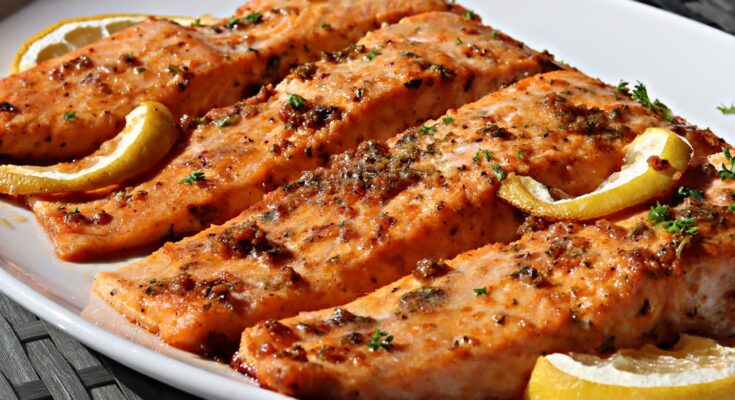Lemon Salmon Recipe: Salmon on its own is already a culinary treasure—rich, flavorful, and versatile. But when you add lemon to the mix, magic happens. The sharp acidity of lemon perfectly balances the buttery texture and slightly sweet flavor of salmon. It’s like pairing yin with yang, creating a dish that’s light, bright, and totally satisfying. The citrus cuts through the natural oils in the fish, enhancing rather than masking its flavor.
This combination isn’t just delicious—it’s been cherished in kitchens worldwide for years. From Mediterranean to modern American cuisine, lemon and salmon make frequent appearances together. Why? Because it works. The vibrant aroma of lemon paired with herbs like dill, parsley, or thyme lifts the dish to restaurant-quality without the need for complicated techniques or rare ingredients.
Cooking lemon salmon is also a gateway recipe. Whether you’re just starting out or you’re a kitchen pro, it’s simple enough for beginners but elegant enough to impress guests. Whether you bake it, pan-sear it, or grill it, the core idea remains the same: fresh ingredients, done right.
Health Benefits of Lemon Salmon
Eating lemon salmon isn’t just about treating your taste buds—it’s a powerhouse of nutrients. Salmon is rich in omega-3 fatty acids, which are essential for heart health, brain function, and reducing inflammation. It’s also packed with high-quality protein, vitamin B12, selenium, and potassium.
Now throw lemon into the mix, and you’re boosting the nutrition even further. Lemons are high in vitamin C, an antioxidant that helps support your immune system, fight oxidative stress, and even improve iron absorption from other foods. The acid from lemon also aids digestion, making the entire meal easier on your stomach.
Together, these ingredients form a nutritious, balanced dish that supports a healthy diet. Whether you’re counting calories, aiming to eat clean, or just looking to make better food choices, lemon salmon is a smart and delicious option.
Ingredients You’ll Need
Fresh vs Frozen Salmon: What’s Better?
Let’s clear something up—both fresh and frozen salmon can make a fantastic dish. The key is knowing what to look for. Fresh salmon should be firm, moist, and smell like the ocean—not fishy. It’s ideal if you’re planning to cook it the same day. Look for vibrant, rich pink or orange hues depending on the species.
Frozen salmon, on the other hand, is often flash-frozen right after being caught. That means it can be just as high in quality—sometimes even higher—than “fresh” salmon that’s been sitting in a display case for days. Just make sure to thaw it properly: leave it in the fridge overnight, or use a cold water bath for quicker results.
For this lemon salmon recipe, either option works beautifully. Just remember: the better the quality of the salmon, the better the final dish.
Choosing the Right Lemons and Herbs
Not all lemons are created equal. For cooking, you want fresh, juicy lemons that feel heavy for their size. Organic is best if you’re using the zest, as conventional lemons may have a waxy coating or pesticide residues. Meyer lemons are sweeter and less acidic than regular lemons, so if you’re looking for a mellower flavor, they’re a great pick.
Herbs play a big supporting role here. Fresh dill is classic and pairs wonderfully with salmon and lemon. You can also use parsley, thyme, basil, or even cilantro if you’re feeling bold. Don’t be afraid to mix and match—just keep it fresh. Dried herbs will work in a pinch, but fresh ones bring out that vibrant, garden-fresh flavor that really elevates the dish.
Here’s a quick ingredient list for reference:
- 2 salmon fillets (about 6 oz each)
- 2 tablespoons olive oil
- 2 garlic cloves, minced
- 1 lemon (zested and juiced)
- Salt and pepper to taste
- 1 tablespoon fresh dill (or other herbs of choice)
- Lemon slices for garnish
Kitchen Tools and Equipment
Must-Have Utensils for Cooking Salmon
To make this recipe smooth and stress-free, a few basic tools will make all the difference. First up, you need a good non-stick skillet or a baking sheet if you’re roasting. A cast iron pan is excellent for searing—it retains heat well and creates a beautiful golden crust.
You’ll also want:
- A sharp chef’s knife: For slicing lemons and herbs with precision.
- A citrus zester or microplane: To get that fragrant lemon zest without the bitter pith.
- Tongs or a fish spatula: Helps you flip and serve the salmon without breaking it apart.
- Mixing bowls: For prepping the marinade and tossing herbs.
Quality tools don’t just make cooking easier—they help ensure consistent results. If you’re baking your salmon, lining your tray with parchment paper or foil can also save you cleanup time later.
Optional Tools to Elevate Your Dish
Want to take things up a notch? These extras can help:
- Food thermometer: Ensures your salmon reaches the perfect internal temperature (145°F/63°C).
- Mandoline slicer: For thin, even lemon slices that look great as a garnish.
- Air fryer: For a crispy-skinned salmon with minimal oil.
Having these tools on hand isn’t mandatory, but they can certainly make your life easier and your lemon salmon tastier.
Step-by-Step Guide to Making Lemon Salmon
Step 1: Prepping the Ingredients
This is where the foundation of flavor begins. Start by patting your salmon fillets dry with paper towels—this helps the seasoning stick and prevents steaming. Season both sides generously with salt and pepper. Set aside.
Next, prep your lemon. Use a zester or microplane to grate the outer peel of the lemon, avoiding the white pith. Then cut the lemon in half and squeeze out the juice into a small bowl. You’ll need both zest and juice—one adds brightness, the other adds bold acidity.
Finely mince the garlic, and chop your herbs if using fresh. Mix the olive oil, lemon juice, lemon zest, garlic, and herbs together in a bowl. Give it a quick taste—it should be zippy, herby, and full of citrusy aroma.
Now you’re ready to move on to the next step: marination.
Step 2: Marinating the Salmon
Marination is where all the flavors start to soak in and transform your salmon from basic to bold. Place your seasoned salmon fillets into a shallow dish or a zip-top bag. Pour the lemon-herb marinade over the top, ensuring every piece is well coated. Use your hands or a spoon to gently massage the marinade into the fish, especially into the crevices where flavor can hide.
Now, let it rest. The magic number for marinating lemon salmon is between 20 to 30 minutes. Too little time, and the flavor won’t penetrate. Too long, and the acid from the lemon can start to “cook” the salmon, altering its texture. So, stick with the sweet spot.
If you’re planning ahead, marinate it in the fridge but take it out about 10 minutes before cooking. Room temperature salmon cooks more evenly and gives you that perfectly flaky texture we’re aiming for.
For an extra layer of flavor, toss in a few lemon slices and extra sprigs of herbs directly into the marinade. These will roast or sizzle beautifully later, enhancing both the aroma and the presentation.
Step 3: Pan-Searing or Baking?
Ah, the great debate: searing or baking. Both methods are excellent, and the right one depends on your mood, your tools, and the texture you’re after.
Pan-searing gives you a beautifully crisped exterior and succulent interior. Heat a non-stick or cast iron skillet over medium-high heat. Add a tablespoon of olive oil and wait until it shimmers. Place the salmon fillets skin-side down (if skin-on), and sear for 4–5 minutes without moving them. Flip gently and cook another 2–3 minutes on the other side. Add lemon slices to the pan during the last minute to caramelize them slightly.
Baking, on the other hand, is easier and hands-off. Preheat your oven to 375°F (190°C). Place the marinated salmon on a lined baking tray and bake for 12–15 minutes, depending on thickness. You’ll know it’s done when it flakes easily with a fork and the internal temp hits 145°F (63°C).
If you want a hybrid approach, you can sear it quickly for a crust, then finish in the oven. This method is great when cooking thicker cuts.
Step 4: Cooking to Perfection
Cooking salmon is all about timing and temperature. Overcooked salmon turns dry and chalky, while undercooked salmon can be mushy and unappetizing. So what’s the secret to that perfect, restaurant-style bite?
First, always preheat your cooking surface—whether that’s a skillet, grill, or oven. Next, use a timer. For fillets about 1-inch thick, 10–12 minutes of total cooking time is usually ideal. But instead of relying purely on time, keep an eye on the texture.
Look for these signs:
- The flesh turns opaque and flakes easily with a fork.
- It springs back when gently pressed.
- The internal temperature reads 145°F (use a thermometer if you have one).
Also, remember salmon continues to cook slightly after being removed from heat, thanks to carryover cooking. Let it rest for 2–3 minutes before serving. This lets juices redistribute, keeping your fillet moist and flavorful.
For a final flourish, drizzle with a touch of fresh lemon juice and sprinkle with sea salt or flaky finishing salt. You’ve just nailed the cooking stage.
Step 5: Garnishing and Serving
Let’s face it—presentation matters. A beautifully plated dish enhances the experience and makes your lemon salmon feel like a gourmet treat. Once your salmon is cooked, gently transfer it to a plate or serving dish.
Top with thin lemon slices, fresh herbs like dill or parsley, and perhaps a small drizzle of olive oil or even a garlic-butter sauce if you’re feeling indulgent. The contrast of golden salmon, green herbs, and bright yellow lemon makes this dish as stunning as it is tasty.
What about sides? Lemon salmon pairs wonderfully with:
- Steamed or roasted vegetables (think asparagus, broccoli, or green beans)
- Rice pilaf or quinoa
- Mashed potatoes or garlic roasted potatoes
- A crisp garden or Caesar salad
If you’re hosting or want to impress someone special, serve the salmon over a bed of arugula or baby spinach, letting the hot salmon slightly wilt the greens. Add a final squeeze of lemon, and voilà—you’ve created a healthy, delicious meal that looks as good as it tastes.
Tips and Tricks for the Best Lemon Salmon
Common Mistakes to Avoid
Even the simplest recipes have pitfalls. Here are a few common mistakes people make when preparing lemon salmon—and how you can avoid them.
- Over-marinating – Lemon is acidic, which is great for flavor but tough on delicate proteins. If you let your salmon sit in lemon juice too long, it starts to “cook” the flesh (like ceviche) and breaks down the texture. Limit marination time to 30 minutes max.
- Using low-quality salmon – You don’t have to splurge on wild-caught king salmon every time, but do aim for fresh, well-sourced fish. Avoid overly fishy-smelling fillets and always look for firm texture and vibrant color.
- Cooking on too high or too low heat – High heat can burn the outside before the inside cooks, while low heat can make the salmon mushy. Medium to medium-high is your sweet spot for pan-searing. For baking, stick to 375°F–400°F.
- Skipping the rest time – Just like steak, salmon benefits from a few minutes of resting after cooking. This lets the juices redistribute and prevents the salmon from drying out when you cut into it.
- Overcrowding the pan – Cooking more than two fillets at once in a pan? Don’t. You’ll steam the salmon instead of searing it, which can ruin the texture and color. Give each fillet space to breathe.
Avoiding these traps ensures your lemon salmon is flavorful, tender, and beautifully cooked every single time.
Flavor Boosting Tips
Want to turn your already-delicious lemon salmon into a flavor explosion? Try these tricks:
- Add a touch of honey or maple syrup to the marinade – This balances the acidity of lemon and adds a subtle caramelized crust when cooked.
- Incorporate mustard – A teaspoon of Dijon mustard in the marinade brings a rich, tangy depth that complements both lemon and salmon.
- Use compound butter – Mix softened butter with lemon zest, minced garlic, and herbs. Dollop this on top of your hot salmon right before serving for next-level richness.
- Add capers – These briny little bombs add a salty punch that contrasts beautifully with the citrusy salmon.
- Smoked paprika or chili flakes – For a little heat and smoky undertone, sprinkle some onto your fillet before cooking. Just a pinch adds dimension.
- Roast with veggies – Try surrounding your salmon with cherry tomatoes, thinly sliced zucchini, or bell peppers on the same tray. They soak up the lemony juices and create an easy one-pan meal.
These small additions can completely transform the flavor profile and keep your dish feeling fresh and exciting each time you make it.
FAQs about Lemon Salmon Recipe
Can I use bottled lemon juice instead of fresh?
Technically, yes—but fresh lemon juice is always better. Bottled lemon juice often contains preservatives that can dull the bright, zesty flavor. Fresh lemons provide a more vibrant, natural citrus taste and a richer aroma, especially if you’re using the zest.
What sides go best with lemon salmon?
Lemon salmon pairs well with a variety of sides. Try it with roasted vegetables like asparagus or Brussels sprouts, a light salad, garlic mashed potatoes, or rice pilaf. Whole grains like quinoa or farro also make great companions.
Can I grill the salmon instead of baking it?
Absolutely! Grilling adds a delicious smoky flavor and beautiful grill marks. Just make sure to oil the grates and cook the salmon skin-side down over medium heat for about 4–5 minutes per side, depending on thickness.
How do I store and reheat leftovers?
Store leftover salmon in an airtight container in the fridge for up to 3 days. Reheat gently in the oven at 275°F for 10–12 minutes or microwave it on low for 1–2 minutes. Avoid high heat to prevent drying it out.
Is this recipe good for meal prep?
Yes! Lemon salmon holds up well in the fridge and can be used in salads, grain bowls, wraps, or eaten cold with veggies. Make a few fillets in advance and store them individually for easy weekday meals.
Conclusion
Lemon salmon is more than just a healthy dinner—it’s a flavorful, vibrant experience that can be made in under 30 minutes, yet feels like a gourmet meal. With the perfect harmony of tangy citrus and rich, buttery salmon, this dish delivers every time.
Whether you’re a beginner cook or a seasoned pro, the beauty of this recipe lies in its simplicity. With fresh ingredients, just the right technique, and a little love, you’ll have a go-to recipe that impresses every time. It’s great for weeknight dinners, fancy occasions, or meal prepping for the week.
So next time you’re wondering what to cook, let lemon salmon be your answer. It’s quick, delicious, and a guaranteed crowd-pleaser. Plus, your body will thank you for the wholesome, nutrient-packed meal.



